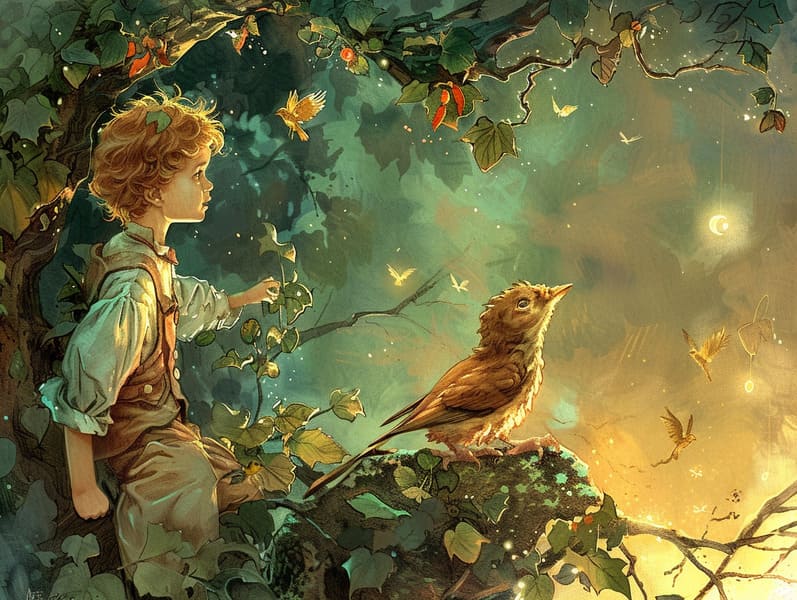
Children's fairy tales have enduring presence. These stories have been told from one generation to the next long before they were ever recorded. They came from a variety of cultures, including European traditions. They were initially told among mature audiences, often carrying themes and messages related to the societal norms and beliefs of the time.
The Brothers Grimm, Jacob and Wilhelm, were among the first to collect many of these beloved stories. Their volume, "Grimm's Fables," included narratives like "Cinder Maid," "Hansel and Grethel," and "The True Story of Snow White," which have since become cornerstones in the world of children's fairy tales. Similarly, Hans Christian Andersen's magical fairy tales, such as "The Story of the Little Mermaid," and "The Ugly Duckling," have won hearts worldwide, securing their place in the pantheon of famous fairy tales.
Despite their historical roots, these tales remain as important as ever, especially as nighttime stories for kids. These enchanting tales are now available in multiple formats, including colorful picture books, enchanting animations, and digital storybooks.
Their continued relevance can be ascribed to several delightful features:
Life Lessons: Traditional fairy tales often provide important moral lessons. Stories like "The Shepherd Boy and the Wolf" teach the significance of being truthful, while "The Hare and the Tortoise" exemplify the virtues of persistence and unpretentiousness. These stories offer young ones clear distinctions between good and bad, molding their moral compass in a gentle yet important way.
Empathy and Understanding: Classic fairy tales frequently involve characters facing difficulties and adversities, urging audiences to sympathize with their struggles and cheer for their triumphs. For instance, "Beauty's Beast" reveals the benefit of seeing beyond the surface to perceive the inner being of a individual, fostering insight and comprehension.
Cultural Insights: Many fairy tales are infused with the cultural contexts from which they came. Learning from these narratives can provide informative snapshots into different social structures, building a sense of world awareness and knowledge.
Creativity and Fantasy: The supernatural elements in fairy tales—spells and potions—enliven children’s creative dreams. These stories take readers to fantastical realms, revitalizing inventive dreams and a sense of enchantment that stays a lifetime.
Classic fairy tales are not only charming but also illuminating. They serve as mesmerizing tools in developing various intellectual and emotional capacities in little ones. When timeless fairy tales are read aloud, they nurture language proficiency by bringing new linguistic elements and sophisticated sentence structures. This practice also boosts listening skills and attentiveness, as young readers remain attentive, eager to see what happens next.
Furthermore, deliberating the themes and characters of fairy tales can strengthen reasoning skills and intellectual skills. Little ones are guided to identify patterns, make predictions, and figure out cause and effect. These talks also encourage young readers speak out their thoughts and feelings, adding to their emotional intelligence.
In today’s electronic age, the abundance of web-based fairy tales has made these tales more reachable than ever. Web-based platforms and digital apps extend vast collections of ancient fairy tales that can be seen or listened through anytime, anywhere. Fairy tales recited are particularly common, supplying an interactive way for children to savor these spellbinding stories. Narrated books and read-to-me videos lead characters and settings to life, often augmented by fantastical soundtracks and music that improve the tale-telling adventure.
The everlasting appeal of traditional fairy tales lies in their ability to modify to the present while sustaining their core values. Contemporary retellings of these fairy tales often incorporate more multicultural figures and modern settings, making them understandable to today’s audience. However, the essential messages of fortitude, goodness, and rightness remain unchanged, continuing to touch kids of all ages.
Classic fairy tales also offer a sense of contentment and knowability. They bestow a neat narrative with a transparent beginning, middle, and end, often closing with the closure of conflicts and the triumph of righteousness over wickedness. This dependability can be placating for kids, sharing a sense of dependability in an fluctuating world.
Old fairy tales continue to fascinate and edify new generations, maintaining their delight and impact in modern society. As bedtime stories click here for kids, they extend a perfect blend of magic and knowledge, encouraging moral values, empathy, and creativity. The existence of online storybooks and the prevalence of fairy tales told out loud ensure that these old narratives remain available to new generations.
By conserving and telling these tales, we continue to appreciate the rich tapestry of folklore and cultural heritage. Whether you are accessing a colorful picture book, enjoying a cyber collection, or listening on an audio story, the elegance of old fairy tales is always within reach. These narratives emphasize of the perpetual force of stories and its ability to unify us across centuries and lands.
Whether you are experiencing a richly illustrated book, delving into a internet collection, or listening through an voice book, the allure of traditional fairy tales is always within reach.
These stories reveal of the continued power of fairy tales and its ability to tie us across centuries and lands, creating a bond that delights and instructs alike.